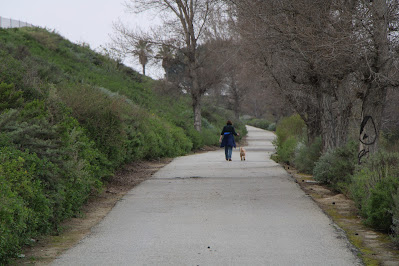In highly urbanized parts of Southern California, nature preserves come in all shapes and sizes. This morning, under partly sunny skies and temperatures in the low 60’s, Caroline, Riley and I are hiking an earthen trail in Dominguez Gap Wetlands, near Long Beach. In 2008, a 37-acre, linear drainage basin was converted to a wetlands where flows from the LA River and local urban runoff were routed through to naturally clean up pollutants such as fecal coliform and heavy metals, while also providing a year-round habitat for native plants and wildlife. Soon, I spot a male House Finch and a Mourning Dove perching in a mostly-leafless deciduous trees. On both sides of the trail, I notice blossoms of Coastal Sunflower and White Sage. High above the water, perched on a powerline, I observe a Belted Kingfisher. This bird can see fish almost 100 yards away. It darts out and dives down to snatch one up and then returns to the perch. Further ahead, I come upon a perching Black-crown Night Heron. These social birds breed in colonies of stick nests usually built over water (stock photo). Scientists find it easy, if a bit smelly and messy, to study the diet of young Black-crowned Night Herons—the nestlings often disgorge their stomach contents when approached. On the water, I spot a mating pair of Northern Shovelers. Northern Shovelers are monogamous and remain together longer than most pairs of other dabbling ducks. They form bonds on their wintering grounds and stay together until just before fall migration. Swimming along the far shore, I watch an American Coot and a group of male Mallards. Arriving at the far end of the wetlands, I pause to take in this unique preserve. Heading back on the other side, I notice the red blossoms of a Bottle Brush tree and a swimming Pied-billed Grebe, before it dives under the water. Next, I can barely make out a juvenile Black-crown Night Heron, well-camouflaged as it perches in a patch of dead reeds on the far shore. Young Black-crowned Night Herons, like this one, leave the nest at the age of one month but cannot fly until they are six weeks old. They move through the vegetation on foot, joining up in foraging flocks at night. On the water’s edge, I come upon a perching Great Blue Heron and a pair of Western Pond turtles. These turtles are omnivorous. They eat a variety of insects, tadpoles, frog eggs, snails, leeches, aquatic beetles, dragonfly larvae and fish. Plant foods include filamentous algae, lily pads and cattail roots. Approaching the car, I’m reminded that places like this not only provide refuge for wildlife but also for a few homeless humans.
Dynamics of nature may seem cruel
Kill or be killed is a general rule
A life must be taken to help another
One will make it, but not the other
Creature lies dead on the ground
Food for the living has been found
I mourn the end of its beautiful life
Hope it was quick, no pain or strife
Whether it be near or yon
Cycle of life and death goes on

Seeing many of the same things here near San Diego.
ReplyDelete